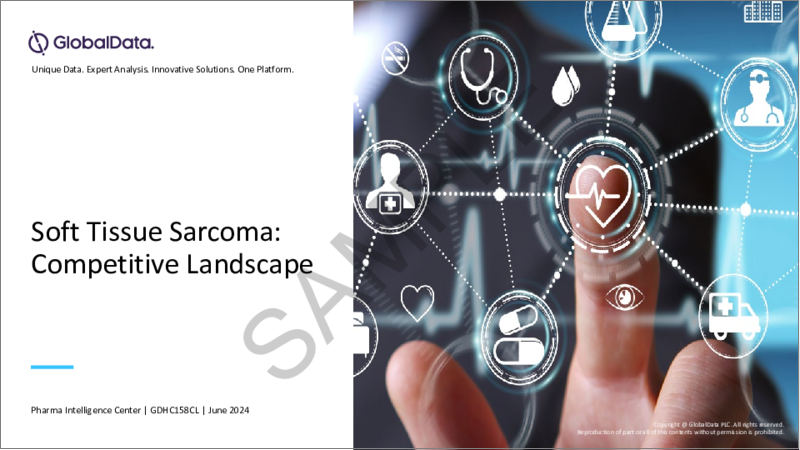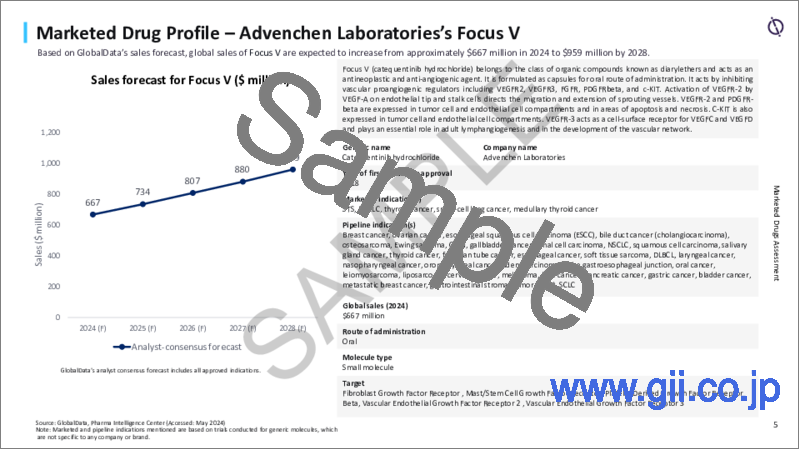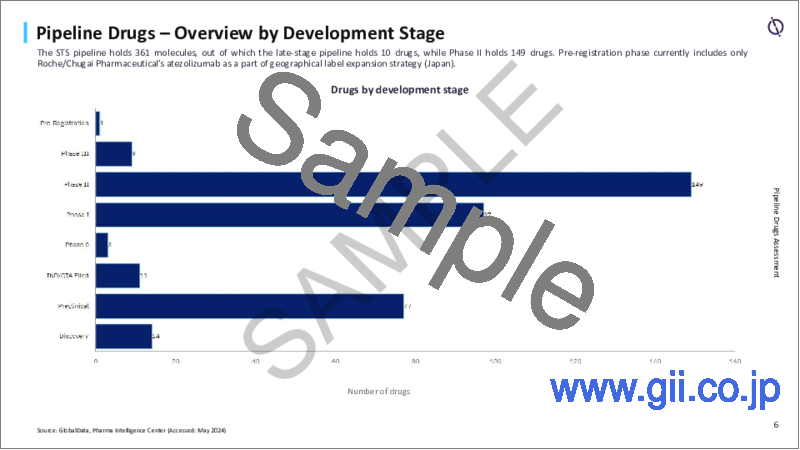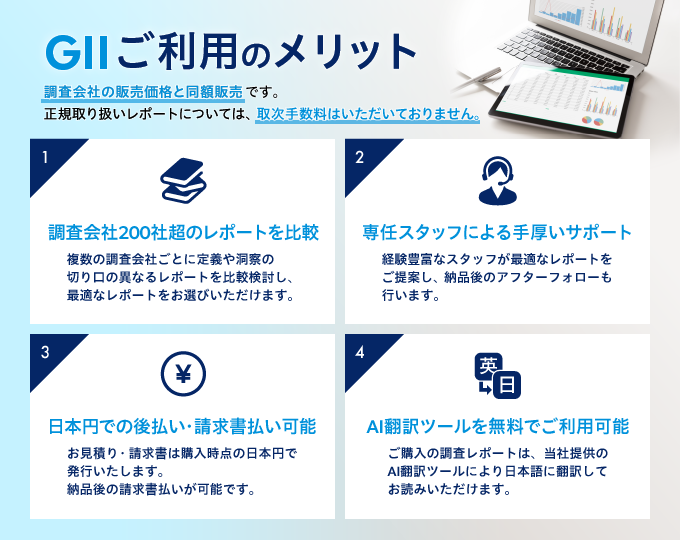|
|
市場調査レポート
商品コード
1520930
軟部肉腫市場 - 競合情勢Soft Tissue Sarcoma: Competitive Landscape |
||||||
カスタマイズ可能
適宜更新あり
|
|||||||
| 軟部肉腫市場 - 競合情勢 |
|
出版日: 2024年06月26日
発行: GlobalData
ページ情報: 英文 79 Pages
納期: 即納可能
|
全表示
- 概要
- 目次
概要
2024年には、16カ国で30万人以上の軟部肉腫診断有病例が予測されています。
現在、軟部肉腫市場には多くの革新的医薬品が存在します。 Roche、BMS、Novartis、Boehringer Ingelheimなどの著名企業が軟部肉腫の主要参入企業です。軟部肉腫の研究開発活動は活発で、パイプラインには361分子が存在し、そのうち後期パイプラインには10種類の薬剤があります。
米国は軟部肉腫臨床試験の主要国として台頭してきています。北米、欧州、アジア太平洋地域では、パートナーシップが取引の大半を占めています。
当レポートでは、世界の軟部肉腫市場について調査し、疾患の概要とともに、治験動向、パイプライン概要、将来の見通しなどを提供しています。
目次
第1章 序文
第2章 主な調査結果
第3章 病気の情勢
- 疾患の概要
- 疫学の概要
- 治療の概要
第4章 上市済み薬剤の評価
- 主要な上市済み薬剤
- 作用機序別概要
- 投与経路別概要
- 製品プロファイルと売上予測
第5章 価格設定と償還評価
- 年間治療費
- 価格設定と償還までの時間
第6章 パイプライン薬剤の評価
- 中期から後期段階のパイプライン薬剤
- 開発段階別概要
- 作用機序別概要
- 分子タイプ別概要
- 薬剤固有の相転移成功率(PTSR)と承認可能性(LoA)
- 治療領域と適応症別のPTSRとLoA
第7章 臨床試験の評価
- 歴史的概要
- 相別概要
- ステータス別概要
- 進行中および計画中の試験の相別概要
- 仮想コンポーネントを使用した治験
- 地理的概要
- 地域別の単一国および多国籍試験
- 上位20のスポンサーと相別内訳
- 上位20のスポンサーのステータス別内訳
- エンドポイントステータス別概要
- 人種および民族別の概要
- 登録データ
- 治験サイトの上位20か国
- 世界のトップ20サイト
- 実現可能性分析- 地理的概要
- 実現可能性分析- ベンチマークモデル
第8章 取引の情勢
第9章 商業的評価
- 主要な市場参入企業
第10章 将来の市場カタリスト
第11章 付録
目次
Product Code: GDHC158CL
This reports provides a data-driven overview of the current and future competitive landscape in soft tissue sarcoma therapeutics.
- In 2024, more than 300,000 diagnosed prevalent cases of STS are anticipated in the 16 countries covered in GlobalData's epidemiology forecast for STS.
- Currently, the market space for STS holds many innovator drugs. Prominent companies such as Roche, BMS, Novartis, and Boehringer Ingelheim are the key players for STS.
- R&D activities for STS are strong with 361 molecules in the pipeline, out of which the late-stage pipeline holds 10 drugs.
- The US is emerging as the key country for conducting STS trials.
- Partnerships dominated the deal landscape in North America, Europe and Asia-Pacific.
Scope
GlobalData's soft tissue sarcoma: Competitive Landscape combines data from the Pharma Intelligence Center with in-house analyst expertise to provide a competitive assessment of the disease marketplace.
Components of the report include -
- Disease Landscape
- Disease Overview
- Epidemiology Overview
- Treatment Overview
- Marketed Products Assessment
- Breakdown by Mechanism of Action, Route of Administration
- Product Profiles with Sales Forecast
- Pricing and Reimbursement Assessment
- Annual Therapy Cost
- Time to Pricing and Time to Reimbursement
- Pipeline Assessment
- Breakdown by Development Stage, Mechanism of Action, Molecule Type, Route of Administration
- Product Profiles with Sales Forecast
- Late-to-mid-stage Pipeline Drugs
- Phase Transition Success Rate and Likelihood of Approval
- Clinical Trials Assessment
- Breakdown of Trials by Phase, Status, Virtual Components, Sponsors, Geography, and Endpoint Status
- Enrolment Analytics, Site Analytics, Feasibility Analysis
- Deals Landscape
- Mergers, Acquisitions, and Strategic Alliances by Region
- Overview of Recent Deals
- Commercial Assessment
- Key Market Players
- Future Market Catalysts
Reasons to Buy
- Develop and design your in-licensing and out-licensing strategies through a review of pipeline products and technologies, and by identifying the companies with the most robust pipeline.
- Develop business strategies by understanding the trends shaping and driving the soft tissue sarcoma market.
- Drive revenues by understanding the key trends, innovative products and technologies, and companies likely to impact the global soft tissue sarcoma market in the future.
- Formulate effective sales and marketing strategies by understanding the competitive landscape and analyzing the performance of various competitors.
- Identify emerging players with potentially strong product portfolios and create effective counter-strategies to gain a competitive advantage.
- Organize your sales and marketing efforts by identifying the market categories that present the maximum opportunities for consolidations, investments, and strategic partnerships.
Table of Contents
1 Table of Contents
1 Preface
- 1.1 Contents
- 1.2 Report Scope
- 1.3 List of Tables and Figures
- 1.4 Abbreviations
2 Key Findings
3 Disease Landscape
- 3.1 Disease Overview
- 3.2 Epidemiology Overview
- 3.3 Treatment Overview
4 Marketed Drugs Assessment
- 4.1 Leading Marketed Drugs
- 4.2 Overview by Mechanism of Action
- 4.3 Overview by Molecule Type
- 4.4 Product Profiles and Sales Forecast
5 Pricing and Reimbursement Assessment
- 5.1 Annual Cost of Therapy
- 5.2 Time to Pricing and Reimbursement
6 Pipeline Drugs Assessment
- 6.1 Mid-to-late-stage Pipeline Drugs
- 6.2 Overview by Development Stage
- 6.3 Overview by Mechanism of Action
- 6.4 Overview by Molecule Type
- 6.5 Drug Specific Phase Transition Success Rate (PTSR) and Likelihood of Approval (LoA)
- 6.6 Therapy Area and Indication-specific PTSR and LoA
7 Clinical Trials Assessment
- 7.1 Historical Overview
- 7.2 Overview by Phase
- 7.3 Overview by Status
- 7.4 Overview by Phase for Ongoing and Planned Trials
- 7.5 Trials with Virtual Components
- 7.6 Overview of Trials by Geography
- 7.7 Single-Country and Multinational Trials by Region
- 7.8 Top 20 Sponsors with Breakdown by Phase
- 7.9 Top 20 Sponsors with Breakdown by Status
- 7.10 Overview by Endpoint Status
- 7.11 Overview by Race and Ethnicity
- 7.12 Enrollment Data
- 7.13 Top 20 countries for Trial Sites
- 7.14 Top 20 Sites Globally
- 7.15 Feasibility Analysis - Geographic Overview
- 7.16 Feasibility Analysis - Benchmark Models
8 Deals Landscape
- 8.1 Mergers, Acquisitions, and Strategic Alliances by Region
- 8.2 Recent Mergers, Acquisitions, and Strategic Alliances
9 Commercial Assessment
- 9.1 Key Market Players
10 Future Market Catalysts
11 Appendix
- 11.1 Methodology
- 11.2 Methodology - Sales Forecast
- 11.3 Methodology - Pricing and Reimbursement
- 11.4 Methodology - PTSR and LoA Analysis
- 11.5 About the Authors
- 11.6 Contact Us
- 11.7 Disclaimer






